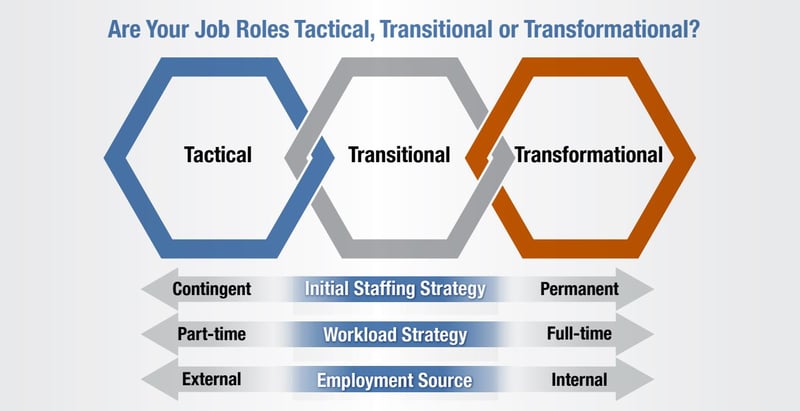With uncertainty around wages, worker supply and the demand for products and services against a backdrop of rising prices, employers are asking, “What’s my labor strategy now?”
 |
If you prefer, you can download the PDF of this Talent Pulse Briefing. |
Just as we’re beginning to recover from the pandemic, along comes the highest rate of inflation in 40 years. The war in Ukraine is accelerating that inflation, and will create supply chain disruption, along with fallout from the humanitarian crisis. There is uncertainty around wages, worker supply and the demand for products and services against a backdrop of rising prices. The situation has employers asking, “What’s my labor strategy now?”
How long is inflation likely to last?
Inflation is affecting what individuals, families and organizations pay for goods, services and utilities. Consumer prices rose 0.8% in February and 7.9% compared to one year ago, according to the U.S Labor Department. This is the fastest rate of increase since 1982. Federal Reserve Board President Jerome Powell says that he will use all of the reserve’s tools to fight inflation but the effects will not be immediate. According to Forbes, inflation will continue throughout 2022 and will probably remain high through 2024. Economist Charles Goodhart has gone even further, pointing out that underpriced labor has kept prices for goods and services low for decades and with higher wages comes higher prices for goods and services, fueling an inflationary period that may last decades.
Employer watch-outs that could impact your business
Wages have not yet stabilized.
Wages grew rapidly in January 2022, with average hourly wages up 5.4% from a year
earlier. Will this continue? Wage price changes occur when we have excessive demand, economic shocks, and worker leverage. All three of these factors are currently in place. Soaring inflation is the economic shock — it’s already wiping out wage gains. Inflation adjusted average hourly earnings fell 2.6% on a year-on-year basis in February. Moody’s Analytics estimates that inflation at February levels was costing the average household $296.45 per month, up from $276 in January. Typically, people return to the workforce faster during inflation because they need more money – but in the ongoing talent shortage workers still have leverage and they’re still avoiding the lowest paying jobs.
Growing disruption in the global economy
Will the economy — and the labor market — correct itself? If so, when? And what does a correction look like with ongoing global economic disruption including the conflict in Ukraine? While an all-time record U.S. gas price is making headlines, a potentially lesser known impact
looms – the fact that Russia and Ukraine combined provide over 29% of the global wheat supply. Between the fighting in Ukraine and sanctions on Russia, both this season’s and next
season’s harvest is at risk.
In addition, 300,000 companies in the supply chain are at risk from the war in Ukraine. Supply chain disruptions earlier in the pandemic had major repercussions in the manufacturing industry as plants could not produce goods without all the needed supplies. This caused slowed or halted production, resulting in worker layoffs.
Today’s disruptions, however, are unlikely to be as widespread as during the early days of the pandemic, when whole economies were shut down and labor shortages were higher. Meanwhile, as the United States works toward resettling 100,000 Ukrainian refugees, we are looking forward to continuing our partnership with Welcome US to hire and upskill Ukrainians who may soon arrive.
The talent shortage remains a factor — but may be starting to ease
In the December-February time period, there were slight gains in the number of people returning to the workforce. In February, the number of people in the workforce rose by 678,000 while the unemployment rate fell to 3.8%.
There are multiple reasons for these changes:
• Inflation is likely driving people to return to work as savings begin to evaporate. The personal savings rate in the U.S. fell from 8.2% in December to 6.4% in January. For comparison, this rate was 19.9% in January 2021.
• Masking rules have been relaxed, making workers more comfortable in the workplace
• Quarantine timelines have been shortened
• Childcare issues are easing as children are more consistently back in school
Workers remain in the driver’s seat but employers are gaining influence as navigators
Knowing what workers want is critical to employer success in attracting and retaining workers. Wages remain a top consideration, though not the only critical factor for employees.
THRIVE research, conducted by ManpowerGroup in December 2021, provides some clues about what’s most important to workers in the United States.
Top 5 flexibility preferences of workers:
1. Choose start times and end times
2. More vacation time
3. Fully flexible schedule — in the workplace or home as suits my daily circumstances
4. More paid/sick leave entitlement
5. More mental health days off
Top 5 most important benefits of flexible work according to workers:
1. More time with family and friends
2. More time to rest and recover from work
3. More time to do the things I want outside of work
4. A more productive work week
5. A chance to learn new skills
Top 3 purpose-related drivers for workers:
1. Feeling motivated and passionate about the work that I do
2. Leaders that I trust and follow
3. Feeling that the work I do is important to the organization
5 Key Workforce Strategies To Help You Weather the Inflationary Storm
1. Hedge your bets with flexible work models
Get beyond the notion of “owning” the worker and the work. When there is uncertainty in the market, temporary staffing lets you avoid the time commitment and expense required for seeking and hiring full-time staff. Contract workers can usually be onboarded faster and hired for only as long as you’re likely to need them (usually with the flexibility to extend). With temporary workers who are proven performers, you have the option to make them permanent employees and reduce your vacancy and time to productivity cost. Flexible staffing is a great option when production is uncertain or business difficult to predict. Additionally, it’s more achievable to adjust
wages for temporary staff than for permanent staff.
2. Rebalance your temp/perm strategy to align with today's environment
Knowing when and how to leverage permanent, temporary, gig or project workers, or a mix is the million-dollar question. And the answer is driven by the unique knowledge you gain from better understanding your workforce cost, your position amongst competitors and other key factors that influence the right workforce mix for your organization.
Strategic role types and skill levels
• Tactical roles: Often the team members working to scale routine and highly managed core operations and skill areas or meet certain functional and regulatory basics. Contingent lends itself to tactical roles. However, if a tactical role is core to your business, such as customer service, you should own this talent.
• Transitional roles: Workforce team members who continue that effort but add more skills or take on more complexity, dynamic tasks and decisions, while flexing between tactical and transformational categories. Transitional roles tend to include a mix of temporary and permanent talent.
• Transformational roles: Those who are often tasked with change making, innovation, creating new value or executing specific projects often with more unique goals or less routine work patterns. Draw from multiple partners for your transformational talent. While 80% of transformational roles will likely come in the form of permanent talent, when it’s most scarce, you may need to engage specialist firms for project-based talent.

3. Automation - Stay the course
Automation may be critical for your organization to gain and keep a competitive advantage, and inflation merely underscores its importance. Historically, small-to-medium U.S. manufacturers have been slow to adopt digital manufacturing practices. Given our need to be more competitive, productive, and efficient as a nation, we have to stay on track despite fluctuations in the economy.
Skilled technical talent is also essential to not only power digitalization and automation but to maintain and secure it. It’s an important specialization that we’re dedicating time and resources to.
If you’re behind the curve, don’t waste any more time. Use this moment to make or accelerate change; And ensure that you are aligning your workforce strategies to the change – reskilling and training your talent should not be an afterthought, rather a core component of your automation strategy.
4. Know your labor costs and what you can do to optimize and lower them
While technology continues to transform the way we get work done, skills needs are changing rapidly. With drastic market changes, and more uncertainty in public health and global supply chains, achieving workforce success is becoming more complex than ever.
The first step to success is understanding the true cost of your workforce, which is so much more than just wages + benefits. It includes onboarding, turnover, quality, safety, compliance, and more, which can be 1.5 to 3 times what appears in your financial statements.
Our proprietary Total Cost of Workforce tool can help. Your Manpower workforce expert will work with you to enter key data points that go into your overall workforce costs, then show you how to optimize or even lower your costs in a way that improves performance, productivity.
5. Consider Workforce Redesign
Think beyond Business Process Re-engineering (BPR). You could gain a competitive edge by holistically reviewing your workforce and redesigning it in a way that optimizes people and production and even your workforce costs.
The traditional employer mindset is focused on creating the job, posting the job, and expecting that someone will take that job. Traditional approaches may not work in the new world of work. Take this moment to rethink your strategy.
Incorporate realistic job design into the equation. Instead of identifying the work that needs to be done, think about how will it be easiest for the worker to do the task. Think reaching, repetitive trips, loading and lifting. As an example, don’t make heavy lifting part of the job description across the board if only 20% of the tasks require someone to lift that weight. It’s about the task not the workforce.
Incorporate workers’ preferences as well as abilities. For example, work is done more efficiently and workers are more engaged when each person uses a variety of skills to complete a task rather than using one set of skills repeatedly. And considering worker preferences around scheduling could cut down on absences and turnover. In a 2022 Manpower survey of our current Associates and Consultants, we asked when they preferred to work; the majority of workers responding they prefer to get started early on 1st shift.
Redesigning around worker success
According to Harvard Business Review, each employee has to know the answer to four basic questions in order to properly carry out their job:
“What resources do I control to accomplish my tasks?”
“What measures will be used to evaluate my performance?”
“Who do I need to interact with and influence to achieve my goals?”
“How much support can I expect when I reach out to others for help?”
Considering these factors when designing a workforce will attract workers, impact job satisfaction and cut attrition. Once you work hard to get good team members, whether temp or perm, keeping them and inspiring longer-term payoff is critical. Workforce redesign incorporates worker’s reality and can enhance productivity and raise engagement.
Some common low or no-cost ideas:
- Redesign of work stations
- Alternating work assignments between team members if possible
- Accommodations to improve comfort and ergonomics
- Instituting an acclimation coach/buddy system with a more experienced worker
And remember, workers remain solidly in the driver’s seat. Make sure to incorporate their preferences in your strategy – from flexibility of schedule and work location to perks and benefits that are most impactful. Leverage ManpowerGroup research and even conduct your own in order to better understand what matters most to workers today and position yourself as a choice employer.
We are your partner through change.
As we move forward in 2022, companies will need to continue to get comfortable with ambiguity and change. The COVID crisis was a 2-year training ground for this, teaching us how to pivot, and then pivot again. The ability to adapt with energy, flex with ease, and show resilience are essential no matter the market influences or global/local disruption. But agility, flexibility and resilience don’t happen organically. You need proper workforce planning and strategy. Manpower can help you align your workforce strategy with your business needs.





Comments